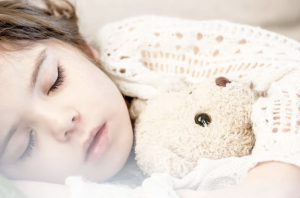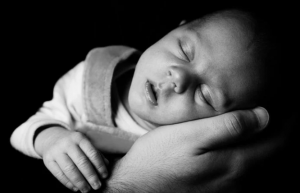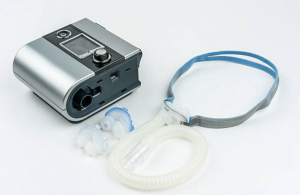Sleep disorders that involve difficulty breathing during sleep are classified as sleep related breathing disorders.
Of these, the most common disorder of this type is Obstructive Sleep Apnea (OSA). Here are the basics you should know about OSA.
OSD is a serious sleep disorder that causes you to stop breathing during sleep. The symptom most commonly associated with sleep apnea is snoring; however, not everyone who snores has sleep apnea. If snoring is paired with choking or gasping sounds, it is likely to be sleep apnea. The symptoms of sleep apnea include:
- Loud or frequent snoring
- Choking or gasping while you sleep
- Pauses in breathing
- Morning headaches
- Excessive daytime sleepiness
- Insomnia due to difficulty staying asleep
- Waking up with dry mouth or a sore throat
- Frequent need to urinate during the night
- Trouble concentrating
- Memory or learning problems
- Moodiness, irritability or depression
In many cases, an apnea, or temporary pause in breathing, is caused by the tissue in the back of the throat collapsing. The muscles of the upper airway relax when you fall asleep. If you sleep on your back, gravity can cause the tongue to fall back. This narrows the airway, which reduces the amount of air that can reach your lungs. When this happens, you may snore loudly or making choking noises as you try to breathe. Your brain and body become oxygen deprived and you may wake up. This may happen a few times a night, or in more severe cases, several hundred times a night.
Sleep Apnea in Children

Because children have smaller lungs, they have less oxygen in reserve. Children tend to take frequent, shallow breaths rather than slow, deep breaths. This also can cause a child with OSA to have too much carbon dioxide in the blood. This is called “hypercapnia.” Even brief apneas can cause a child to have low levels of oxygen in the blood. This is called “hypoxemia.” It can occur quickly in a child with OSA. Cognitive and behavioural problems are common in children with OSA. These problems may include:
- Aggressive behavior
- Attention-deficit/hyperactivity disorder (ADHD)
- Delays in development
- Poor school performance
Unlike adults with OSA who often have fragmented sleep, children with OSA often do not wake up in response to pauses in breathing. They have a higher “arousal threshold” than adults. As a result their sleep pattern tends to be fairly normal. Children with OSA tend to breathe normally when they are awake, but it is common for them to breathe through the mouth. They may have frequent infections of the upper respiratory tract. Some children with OSA have such large tonsils that they have a hard time swallowing. This is called “dysphagia.” Symptoms of OSA tend to appear in the first few years of life, but OSA often remains undiagnosed until many years later. In early childhood OSA can slow a child’s growth rate. Untreated OSA can also lead to high blood pressure.
Sleep Apnea in Infants
Partial reductions in breathing are called “hypopneas.” Complete pauses in breathing are called “apneas.” Infant sleep apnea is a sleep related breathing disorder that involves reductions and pauses in breathing that occur during an infant’s sleep.

In infancy the frequency of these events increases during the stage of rapid eye movement (REM) sleep. The apneas in infant sleep apnea may be central, obstructive or mixed. Central apneas occur when your body decreases or stops its effort to breathe. This results from a problem in the brain or in the heart.
Obstructive apneas occur when soft tissue in the back of the throat collapses and blocks the airway during sleep. Mixed apneas involve a central apnea that is directly followed by an obstructive apnea. The majority of apneas that occur in small premature infants are mixed apneas.
Apneas that occur in larger premature infants and full-term infants tend to be central apneas. These breathing problems can cause severe complications. The infant may not have enough oxygen in the blood. This is known as “hypoxemia.” The infant also may develop a slow heartbeat. This is known as “bradycardia.”
The infant even may lose consciousness and need to be resuscitated. Infant sleep apnea has two general causes. It can be a developmental problem that results from an immature brainstem. It also can be a secondary problem that is caused by another medical condition. It is common for there to be some instability in an infant’s breathing.
This can be a normal part of an infant’s development. Even healthy infants may have a brief central apnea. This pause may be an isolated event. It also may occur after the child sighs or moves. The duration of these normal events is very short. They rarely last longer than 20 seconds. Obstructive apneas are rare in healthy infants.
Are you at risk?
A common misconception is that sleep apnea only affects older, overweight men. This widely-held assumption is wrong: anyone can have sleep apnea, regardless of gender, age or body type. If you have any of the following traits you may be at increase risk:

- Excess weight – An adult with a BMI of 25 or higher is considered to be overweight. Your risk of sleep apnea increases with the amount of excess body weight.
- Large neck size (>17 inches for men, > 16 inches for women) – A large neck will have more fatty tissue that can block your airway.
- Older age (40+ for men, 50+ for women) – Sleep apnea occurs more often in older adults, especially people older than 60.
- Being male – Men have twice the risk having sleep apnea compared to women
- Smoker – Smokers have a higher risk of sleep apnea
- Hypertensive – High blood pressure is very common in people with sleep apnea
- Family history – Sleep apnea can appear more often among family members. This may be a result of either inherited traits or common lifestyles.
Sleep apnea can make you wake up in the morning feeling tired or unrefreshed even though you have had a full night of sleep. During the day, you may feel fatigued, have difficulty concentrating or you may even unintentionally fall asleep.
This is because your body is waking up numerous times throughout the night, even though you might not be conscious of each awakening. The lack of oxygen your body receives can have negative long-term consequences for your health as an adult. These consequences include:
- High blood pressure
- Heart disease
- Stroke
- Pre-diabetes and diabetes
- Depression
Treatment for Sleep Apnea
Sleep apnea is a serious sleep disorder that needs to be treated. Polysomnographic testing is used to help the board certified sleep physician evaluate your problem.
This may include an in-lab overnight sleep study at a sleep centre, or you may be able to use an at-home test. These tests record your brain waves, heartbeat, and breathing among other things. The sleep physician can help you select a treatment plan that is right for you.
Depending on the treatment, he or she may work in collaboration with other members of the sleep team, including dentists, psychologists, physician assistants, nurses and technologists.

Your plan may include any combination of these treatments:
- CPAP (Continuous Positive Airway Pressure), a machine that uses a steady stream of air to gently keep your airway open throughout the night so you are able to breathe.
- Oral Appliance Therapy, using an oral appliance device that fits in your mouth over your teeth while you sleep. It may resemble a sports mouth guard or an orthodontic retainer. The device prevents the airway from collapsing by holding the tongue in position or by sliding your jaw forward so that you can breathe when you are asleep.
- Surgery, which you can elect to have if CPAP or oral appliance therapy does not work for you. The most common options reduce or eliminate the extra tissue in your throat that collapses and blocks your airway during sleep. More complex procedures can adjust your bone structures including the jaw, nose and facial bones. Weight loss surgery may also be an option. Talk to your sleep medicine physician about what surgery is right for you.
- Weight Management, which can help improve or eliminate your sleep apnea symptoms if you are overweight or obese. Overweight people often have thick necks with extra tissue in the throat that may block the airway. There is no guarantee that losing weight will eliminate your sleep apnea, though it may help.
- Positional Therapy, a behavioural strategy to treat positional sleep apnea. Some people have sleep apnea primarily when sleeping on their back. This is called the “supine” position. Their breathing returns to normal when they sleep on their side. Positional therapy may involve wearing a special device around your waist or back that keeps you sleeping in the side position.
- Lifestyle Changes such as quitting smoking or not drinking alcohol may improve sleep apnea symptoms. Alcohol relaxes your throat muscles which can cause you to snore or for your airway to collapse. If you have allergies, taking a decongestant before you go to bed may help improve airflow through your nose.
If you have difficult staying with your treatment plan or cannot sleep even with treatment, your doctor may recommend Cognitive Behavioural Therapy. A behavioural sleep specialist will help you eliminate the thoughts and behaviours that are preventing you from getting restful sleep or complying with your treatment. If you think you may have sleep apnea, find a Board Certified Sleep Physician. You can also try a Free Online Test to determine if you may be suffering from sleep apnea.
Adapted for WellnessConnect from Source: www.isdhealthsolutions.com

